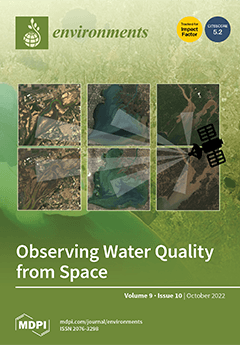Nitrogen contamination is ubiquitous across the globe; as a result of this, the need to understand and predict the extent and effects of nitrogen contamination on microbial ecosystems is increasingly important. This paper utilises a dataset that provides a rare opportunity to observe varying contamination conditions in a single aquifer and understand the differences between potential background bores and two different types of contamination spread across the other bores. Using physicochemical and microbiological community analysis, this paper aims to determine the impacts of the two contaminants, nitrate and ammonia, on the microbial communities and the differences between polluted and physicochemical background bores. Total nitrogen (N) varied by a factor of over 2000 between bores, ranging from 0.07 to 155 mg L
−1. Nitrate (NO
3−) concentrations ranged from 150 to <0.01 mg L
−1; ammonium (NH
4+) concentrations ranged from 26 to <0.1 mg L
−1. MANOVA analysis confirmed an overall significant relationship (
p = 0.0052) between N variables and the physicochemical data (or status) of the three areas of contamination dubbed ‘contamination zones’. The contamination zones were defined by no known presence of contamination in the uncontaminated bores, the presence of NO
3− contamination and the presence of NO
3− and NH
4+ contamination. PERMANOVA analysis confirmed that there was an overall significant difference in the microbial communities between the three contamination zones (
p = 0.0002); however, the presence of NH
4+ had a significant effect (
p = 0.0012). In general, the nitrate-contaminated bores showed a decrease in the abundance of individual OTUs. We further confirmed that NH
4+ contamination had a significant relationship with an increased percentage of abundance occupied by the Planctomycetota phylum (specifically the
Candidatus Brocadia genus). It was found that one of the two background bores (BS-004) was likely also representative of natural microbial background, and another (BS-002) showed characteristics that may be representative of past or intermittent contamination. This paper demonstrates a possible way to determine the microbial background and discusses the potential uses for this information.
Full article





